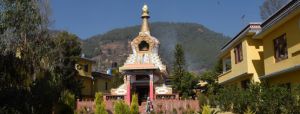Remembering Tenga Rinpoche, a Kagyu Kālacakra master
I am currently on a practice, study and translation retreat at the stunning Benchen monastery, Pharping, Nepal. The two Benchen Monasteries, in Kathmandu and Pharping, Nepal, are the seats of HE the 10th Sangye Nyenpa Rinpoche and also HE Tenga Rinpoche (1932-2012). Tenga Rinpoche is one of the foremost teachers of the Karma Kagyu tradition, and was for many years the Vajra-master (rdo rje slob dpon) at Rumtek monastery in Sikkim, the Indian seat of His Holiness Gyalwang Karmapa, head of the Karma Kagyu tradition.
Born in Kham in 1932, Tenga Rinpoche was recognized as a reincarnation of Lama Samten at the age of seven. As he grew older, he studied at Benchen Monastery[and was eventually given the name Karma Tenzin Thinle Namgyal from Situ Rinpoche. Soon after, he was givenordination by Situ Rinpoche and entered a three-year retreat.
In 1959, Tenga Rinpoche left Benchen for Lhasa. After the 14th Dalai Lama left Tibet in relation with the 1959 Tibetan uprising, he escaped with Dilgo Khyentse Rinpoche, and the brother of Dilgo Khyentse, the 9th Sangye Nyenpa Rinpoche. He then eventually traveled to northern India. In India, he settled at Rumtek Monastery, the main seat of the 16th Karmapa. Tenga Rinpoche served the 16th Karmapa for seventeen years, nine of those years in the position of Dorje Lopön.
In 1976, Tenga Rinpoche settled in Swayambhunath, Nepal, where he founded a second Benchen Monastery and a retreat center in Pharping. In 1986, Tenga Rinpoche established the new Benchen Monastery in Kathmandu.
Benchen Monastery and its retreat centre is situated just below the sacred Asura Caves where the Indian saint, Padmasambhava spent many years meditating. Next to the retreat centre is a kudung stupa housing some of the relics of Tenga Rinpoche. When he passed away he stayed in a meditative state thugdam for four and a half days and left several relics. For more details about his passing away
The stupa design was by HH 17th Karmapa and inside is a Tara Mandala and some of the most beautiful paintings of White Tara and Green Tara (surrounded by the twenty-one Taras) I have ever seen. For a video of the consecration of the stupa in 2014,
In 2005, Tenga Rinpoche gave a Kālacakra empowerment marking the tenth anniversary of the establishment of his Buddhist centre in Grabnik, Poland, Ven. Tenga Rinpoche performed a major Kālacakra empowerment, “The Seven Empowerments Raising the Child”, together with the three abbreviated Ultimate Empowerments. This was the first time that this initiation had been given in its full form in Poland.
The empowerment that Rinpoche gave in Poland is from the main tradition passed in the Karma Kagyu school. This lineage was originally derived from the Jonang tradition, and was later developed in the Karma Kagyu by the famous Jamgon Kongtrul. The text that Tenga Rinpoche used for the empowerment (Drawing Out the Essence of the Ocean of Primordial Awareness ( ye shes rgya mtsho’i bcud ‘dren)) was written by Jamgon Kongtrul, based on the earlier work of the Jonangpas Dolpopa Sherab Gyaltsen and Tāranātha. This empowerment was first given in the West (1982) by Ven. Kalu Rinpoche, himself considered an emanation of Jamgon Kongtrul. Kalu Rinpoche passed the tradition on to Bokar Rinpoche and other Kagyu lamas such as Tenga Rinpoche. For more on this see the short post here on Edward Henning’s website.
For a CD of teachings given by Tenga Rinpoche on Kālacakra see here: https://www.namsebangdzo.com/mobile/Product.aspx?id=1047
The reincarnation of Tenga Rinpoche was discovered in 2014 by HH 17th Karmapa, for information about that extraordinary story see here, and his recognition ceremony with the 17th Gyalwang Karmapa at Benchen Monastery .
May the current Tenga Rinpoche yangsi live long and may the teachings of Karma Kagyu and Kālacakra thrive and flourish!
Source
[[1]]
